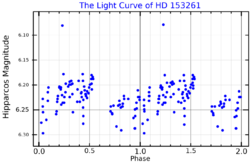Astronomy:HD 153261
| Observation data Equinox J2000.0]] (ICRS) | |
|---|---|
| Constellation | Ara |
| Right ascension | 17h 01m 47.3875s[2] |
| Declination | –58° 57′ 29.681″[2] |
| Apparent magnitude (V) | 6.137[3] |
| Characteristics | |
| Spectral type | B1 V:ne[4] or B2 IVne[5] |
| U−B color index | –0.956[3] |
| B−V color index | –0.078[3] |
| Astrometry | |
| Radial velocity (Rv) | –6[6] km/s |
| Proper motion (μ) | RA: –2.91[2] mas/yr Dec.: –9.01[2] mas/yr |
| Parallax (π) | 2.32 ± 0.38[2] mas |
| Distance | approx. 1,400 ly (approx. 430 pc) |
| Details | |
| Mass | 10.1 ± 0.3[5] M☉ |
| Radius | 4.5[7] R☉ |
| Luminosity (bolometric) | 11,045[8] L☉ |
| Temperature | 21,150[8] K |
| Age | 20.4 ± 0.4[5] Myr |
| Other designations | |
| Database references | |
| SIMBAD | data |
HD 153261 is the Henry Draper Catalogue designation for a star in the southern constellation of Ara. It has an apparent visual magnitude of 6.137,[3] placing it near the threshold of naked eye visibility. According to the Bortle Dark-Sky Scale, it can be viewed from dark suburban or rural skies. Based upon an annual parallax shift of just 2.32 mas,[2] it is located at a distance of around 1,400 light-years (430 parsecs) from Earth.
This star has been catalogued with a stellar classification of B1 V:ne[4] or B2 IVne,[5] indicating that it is either a main sequence or a subgiant star. The 'n' indicates a nebulous spectrum created by the Doppler shift-broadened absorption lines from a rapid rotation, while the 'e' means this is a Be star, with the spectrum showing emission lines from hot, circumstellar gas. HD 153261 displays some variability with an amplitude of 0.090 in magnitude, and is a suspected spectroscopic binary.[1]
HD 153261 is a large star with over ten[5] times the Sun's mass and around 4.5[7] the radius of the Sun. It shines with more than 11,000[8] times the brightness of the Sun, with this energy being radiated into space at an effective temperature of 21,150 K.[8] At this heat, it glows with the blue-white hue of a B-type star.[10]
References
- ↑ 1.0 1.1 Lefèvre, L. et al. (November 2009), "A systematic study of variability among OB-stars based on HIPPARCOS photometry", Astronomy and Astrophysics 507 (2): 11411201, doi:10.1051/0004-6361/200912304, Bibcode: 2009A&A...507.1141L.
- ↑ 2.0 2.1 2.2 2.3 2.4 2.5 van Leeuwen, F. (November 2007), "Validation of the new Hipparcos reduction", Astronomy and Astrophysics 474 (2): 653–664, doi:10.1051/0004-6361:20078357, Bibcode: 2007A&A...474..653V.
- ↑ 3.0 3.1 3.2 3.3 Kozok, J. R. (September 1985), "Photometric observations of emission B-stars in the southern Milky Way", Astronomy and Astrophysics Supplement Series 61: 387–405, Bibcode: 1985A&AS...61..387K.
- ↑ 4.0 4.1 Houk, Nancy (1978), Michigan catalogue of two-dimensional spectral types for the HD stars, 1, Ann Arbor: Dept. of Astronomy, University of Michigan, Bibcode: 1975mcts.book.....H.
- ↑ 5.0 5.1 5.2 5.3 5.4 Tetzlaff, N.; Neuhäuser, R.; Hohle, M. M. (January 2011), "A catalogue of young runaway Hipparcos stars within 3 kpc from the Sun", Monthly Notices of the Royal Astronomical Society 410 (1): 190–200, doi:10.1111/j.1365-2966.2010.17434.x, Bibcode: 2011MNRAS.410..190T.
- ↑ Evans, D. S. (June 20–24, 1966), "The Revision of the General Catalogue of Radial Velocities", in Batten, Alan Henry; Heard, John Frederick, Determination of Radial Velocities and their Applications, Proceedings from IAU Symposium no. 30, 30, University of Toronto: International Astronomical Union, p. 57, Bibcode: 1967IAUS...30...57E.
- ↑ 7.0 7.1 Pasinetti Fracassini, L. E. et al. (February 2001), "Catalogue of Apparent Diameters and Absolute Radii of Stars (CADARS) - Third edition - Comments and statistics", Astronomy and Astrophysics 367 (2): 521–524, doi:10.1051/0004-6361:20000451, Bibcode: 2001A&A...367..521P.
- ↑ 8.0 8.1 8.2 8.3 Hohle, M. M.; Neuhäuser, R.; Schutz, B. F. (April 2010), "Masses and luminosities of O- and B-type stars and red supergiants", Astronomische Nachrichten 331 (4): 349, doi:10.1002/asna.200911355, Bibcode: 2010AN....331..349H.
- ↑ "HR 6304". SIMBAD. Centre de données astronomiques de Strasbourg. http://simbad.u-strasbg.fr/simbad/sim-basic?Ident=HR+6304.
- ↑ "The Colour of Stars", Australia Telescope, Outreach and Education (Commonwealth Scientific and Industrial Research Organisation), December 21, 2004, http://outreach.atnf.csiro.au/education/senior/astrophysics/photometry_colour.html, retrieved 2012-07-21.
External links
 |


